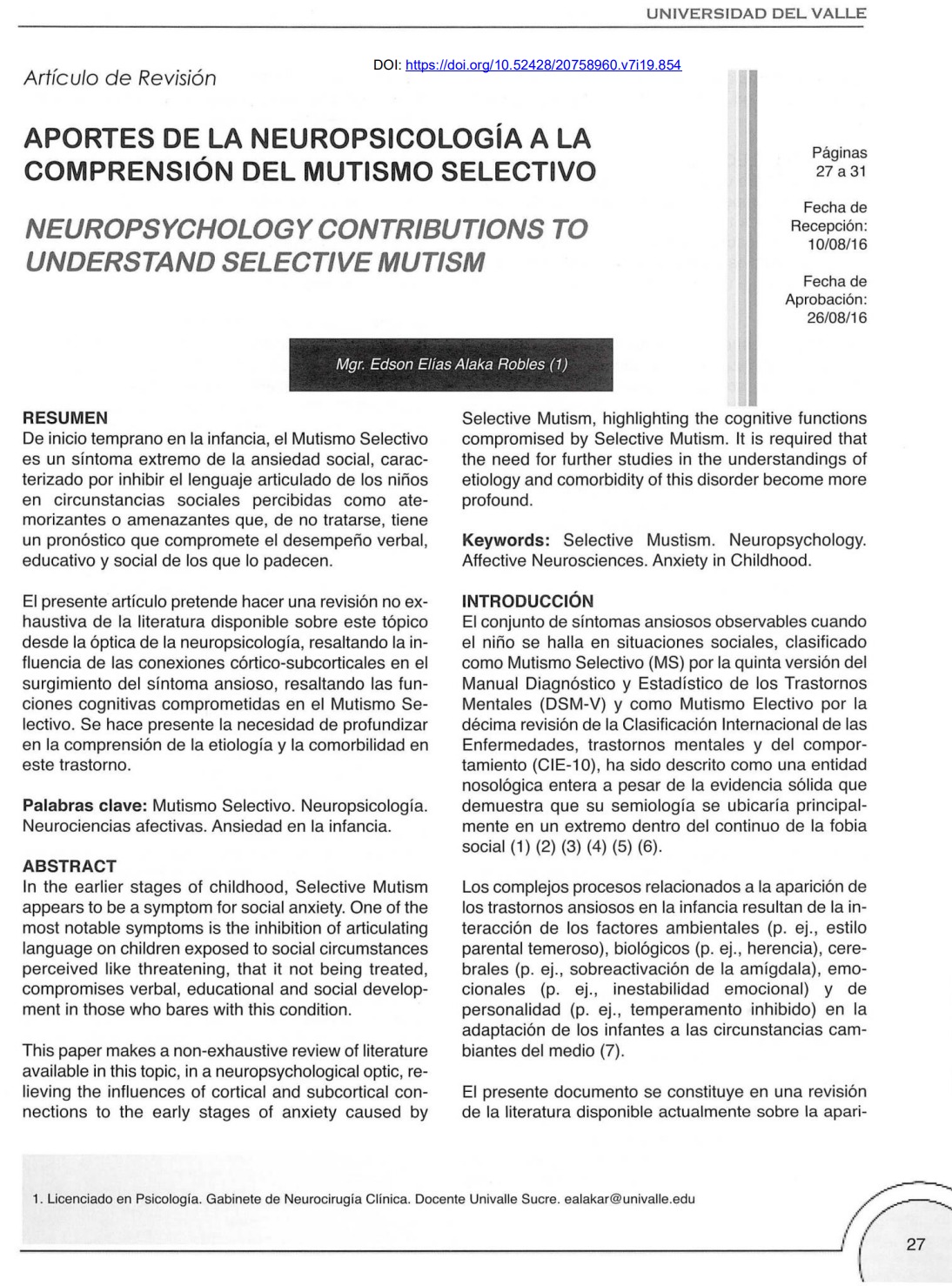Aportes de la Neuropsicología a la Comprensión del Mutismo Selectivo
DOI:
https://doi.org/10.52428/20758960.v7i19.854Palabras clave:
Mutismo Selectivo, Neuropsicología, Neurociencias afectivas, Ansiedad en la infanciaResumen
De inicio temprano en la infancia, el Mutismo Selectivo es un síntoma extremo de la ansiedad social, caracterizado por inhibir el lenguaje articulado de los niños en circunstancias sociales percibidas como atemorizantes o amenazantes que, de no tratarse, tiene un pronóstico que compromete el desempeño verbal, educativo y social de los que lo padecen. El presente artículo pretende hacer una revisión no exhaustiva de la literatura disponible sobre este tópico desde la óptica de la neuropsicología, resaltando la influencia de las conexiones córticosubcorticales en el surgimiento del síntoma ansioso, resaltando las funciones cognitivas comprometidas en el Mutismo Selectivo. Se hace presente la necesidad de profundizar en la comprensión de la etiología y la comorbilidad en este trastorno.
Descargas
Citas
BLACK, B., & UHDE, TW. (1992). Elective mutismas a variant of social phobia. Journal of the American Academy of Child and Adolescent Psychiatry 31:1090-1094. PMid:1342579 https://doi.org/10.1097/00004583-199211000-00015
BLACK, B., & UHDE, TW. (1994). Treatment of elective mutismwith fluoxetine: a double-blind, placebo controlled study. Journal of the American Academy of Child and Adolescent Psychiatry 33:1000-1006. PMid:7961338
https://doi.org/10.1097/00004583-199409000-00010
DOW, S. P., SONIES, B. C., SCHEIB, D., MOSS, S. E., & LEONARD, H. L. (1995). Practica! guidelines for the assessment and treatment of selective mutism. Journal of the American Academy of Child and Adolescent Psychiatry 34:836-846. PMid:7649953 https://doi.org/10.1097/00004583-199507000-00006
ANSTENDIG, K. D. (1999). Is selective mutism an anxiety disorder? Rethinking its DSM-IV classification. Journal of Anxiety Disorders 13:417-434. PMid:10504110 https://doi.org/10.1016/S0887-6185(99)00012-2
GARCIA, A. M., FREEMAN, J. B., FRANCIS, G., MILLER, L. M., & LEONARD, H. L. (2004). Selective mutism. En T. H. Ollendick, & J. S. March (Eds.), Phobic and anxiety disorders in children and adolescents: A clinician's guide to effective psychosocial and pharmacological interventions (pp. 433-455). New York, NY:Oxford University Press.
https://doi.org/10.1093/med:psych/9780195135947.003.0015
BEIDEL, D. C., & TURNER, S. M. (2005). Childhood anxiety disorders: A guide to research and treatment. New York, NY:Taylor & Francis Group.
GARZA, N. (2012). Aproximación al Mutismo Selectivo desde la Psicoterapia lntegrativa Infante Juvenil. AcPI 4:39-75.
GARCIA-MOLINA, A.; ENSENAT-CANTALLOPS, A.; TIRAPU-USTARROZ, J. & RORG-ROVIRA, T. (2009). Maduración de la corteza prefrontal y desarrollo de las funciones ejecutivas durante los primeros cinco años de vida. Rev. Neurol. 48:435-40. PMid:19340785 https://doi.org/10.33588/rn.4808.2008265
KOLVIN, l., & FUNDUDIS, T. (1981 ). Elective mute children: Psychological development and background factors. Journal of Child Psychology and Psychiatry 22:219-232. PMid:6167589 https://doi.org/10.1111/j.1469-7610.1981.tb00548.x
KRISTENSEN, H. (2000). Selective mutism and comorbiditywith developmentaldisorder/delay,anxiety disorder, and elimination disorder. Journal of the American Academy of Child and Adolescent Psychiatry 39:249-256. PMid:10673837 https://doi.org/10.1097/00004583-200002000-00026
STEINHAUSEN, HC., & JUZI, C. (1996). Elective mutism: An analysis of 100 cases. Journal of the American Academy of Child and Adolescent Psychiatry 35:606•614. PMid:8935207 https://doi.org/10.1097/00004583-199605000-00015
KRISTENSEN, H. & OERBECK, B. (2006). Is selective Mutism associated with deficits in Memory Span and Visual Memory? An exploratory case•control study. Depression and Anxiety 23:71•76. PMid:20140 https://doi.org/76.10/da.1002 https://doi.org/10.1002/da.20140
VIEILLARD, S. & HARM, J. (2013). La régulation des émotions au cours du vieillissement normal Revue critique. Année psychologique 113:4. https://doi.org/10.4074/S000350331301405x
BEAUREGARD, M., LEVESQUE, J., & PAQUE• TIE, V. (2004). Neural basis of conscious and volun• tary self•regulation of emotion. En M. Beauregard (Ed.), Consciousness, Emotional Self•Regulation and the Brain (pp. 163•194). Montréal: Johns Benjamins Publishing Company. https://doi.org/194.10/aicr.1075.54bea https://doi.org/10.1075/aicr.54.08bea
MANASSIS K.; FUNG D.; TANNOCK, R.; SLOMAN, L.; FIKSENBAUM, L. & MCINNES, A. (2003). Characterizing selective mutism: Is it more than social anxiety? Depress Anxiety 18:153•161. PMid:10125 https://doi.org/161.10/da.1002 https://doi.org/10.1002/da.10125
OEBECK, B. & KRISTENSEN, H. (2008). Attention in selective mutism An exploratory case•control study. Journal of Anxiety Disorders 22:548•554. PMid:008 https://doi.org/554.10/j.janxdis.1016.2007.04
https://doi.org/10.1016/j.janxdis.2007.04.008
• ASOCIACIÓN AMERICANA DE PSIQUIATRÍA (2014). DSM•5. Manual diagnóstico y estadístico de los trastornos mentales. Madrid: Editorial Médica Panamericana.
• ORGANIZACIÓN MUNDIAL DE LA SALUD. (1992). CIE 10. Décima revisión de la clasificación Internacional de las enfermedades, trastornos mentales y del comportamiento: Descripciones clínicas y pautas para el diagnóstico. Madrid: Meditar.
• VIANA, A.; BEIDEL, D. & RABIAN, B. (2009). Selective Mutism: A review & integration of the last 15 years.Clinical Psychology Review 57•67. PMid:009 https://doi.org/67.10/j.cpr.1016.2008.09 https://doi.org/10.1016/j.cpr.2008.09.009

Descargas
Publicado
Cómo citar
Número
Sección
Licencia
Derechos de autor 2016 Edson Elías Alaka Robles

Esta obra está bajo una licencia internacional Creative Commons Atribución 4.0.
Los autores/as que publiquen en esta revista aceptan las siguientes condiciones:
- Los autores/as conservan los derechos de autor y ceden a la revista el derecho de la primera publicación, con el trabajo registrado con la licencia de atribución de Creative Commons 4.0, que permite a terceros utilizar lo publicado siempre que mencionen la autoría del trabajo y a la primera publicación en esta revista.
- Los autores/as pueden realizar otros acuerdos contractuales independientes y adicionales para la distribución no exclusiva de la versión del artículo publicado en esta revista (p. ej., incluirlo en un repositorio institucional o publicarlo en un libro) siempre que indiquen claramente que el trabajo se publicó por primera vez en esta revista.
- Se permite y recomienda a los autores/as a compartir su trabajo en línea (por ejemplo: en repositorios institucionales o páginas web personales) antes y durante el proceso de envío del manuscrito, ya que puede conducir a intercambios productivos, a una mayor y más rápida citación del trabajo publicado.









